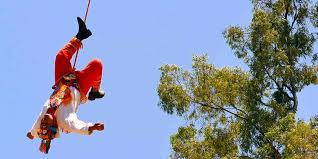As I embarked on my journey through the enchanting landscapes of Xcaret, Mexico, little did I know that I was about to witness a mesmerizing spectacle that would leave an indelible mark on my heart and soul. The air was alive with anticipation as I wandered through this astonishing and unforgettable place, the sun’s warm embrace welcoming me to a world of vibrant colors, rich history, and profound spirituality.
Amidst the vibrant tapestry of Xcaret’s offerings, a distinctive melody began to resonate through the air—notes of flutes and percussion interweaving to create a symphony of anticipation. It was the unmistakable call of the Voladores de Papantla, heralding the commencement of a timeless ritual that would unfold before my eyes. Intrigued, I followed the captivating sounds to their source, my curiosity heightened by the promise of an experience that was steeped in cultural significance.
As I approached the gathering, my senses were immediately enveloped by the vivid hues of the performers’ traditional attire. Their garments were a tapestry of feathers, intricate patterns, and bold colors that caught the sunlight, infusing the scene with a radiant energy. The performers, known as voladores, were in the midst of their preparations, their movements deliberate and purposeful. It was evident that this was no ordinary performance—it was a profound expression of a centuries-old tradition.
With a sense of awe, I watched as these fearless voladores embarked on a journey that transcended the boundaries of the physical world. Their grace and agility were evident as they ascended the towering pole, each movement precise and confident. It was a mesmerizing dance of human determination and spiritual devotion as they conquered the heights with unwavering resolve.
At the pinnacle of the pole, one of the voladores stood tall on a small platform, poised to play his flute—a musical tribute to the divine forces that govern the universe. Meanwhile, the other voladores positioned themselves on ropes that were attached to the apex of the pole, their energy palpable and their spirits alight with excitement.
The haunting melody of the flute resonated through the air, a reverberation of ancient voices echoing across time and space. As if guided by an invisible force, the voladores on the ropes began to slowly spin around the pole’s axis. The moment of transcendence was imminent, and one by one, they released themselves from the platform, their ropes unwinding as they descended earthward.
In that suspended moment between earth and sky, the voladores’ bodies formed a breathtaking spiral—a symbol of the sacred birds that traverse the heavens. Their movements were a dance of devotion, a harmonious blend of rhythm and purpose that evoked a connection to the cosmos. As they spun gracefully and rhythmically towards the ground, the music merged seamlessly with the symphony of the wind and the distant cheers of the captivated crowd.
In witnessing this exhilarating spectacle, I felt a profound sense of unity with Mexico’s indigenous communities, whose legacy and spirituality were woven into every graceful movement. The Voladores de Papantla were not merely performers; they were the custodians of an ancient bond between humanity and the natural world. Through their ritual, they honored the earth, the sky, and the spirits that bridge the two.
As the voladores completed their breathtaking descent, landing safely on the ground to the resounding applause and cheers of onlookers, I was left in awe of the beauty and significance that this ceremony embodied. It was a living testament to the richness of Mexico’s cultural heritage, an homage to the resilience of ancient traditions that have weathered the tides of time.
The Voladores tradition holds its roots firmly in the history of the Totonac people, an indigenous group that has inhabited the region of Veracruz, Mexico, for millennia. The Totonacs, hailed as one of the oldest surviving pre-Columbian cultures in Mesoamerica, carry a legacy that stretches back to around 1600 BCE. While the tradition is most closely associated with the Totonacs, it has also been embraced by other indigenous groups in the region, including the Nahuas and Huastecs.
The Voladores ceremony resonates with deep cultural and religious significance for these indigenous communities. It serves as a means of honoring the gods, seeking blessings for the community, and fostering harmony with nature. This ritual is intricately woven into the fabric of agricultural cycles, where it is believed to play a pivotal role in ensuring abundant harvests and a harmonious relationship with the land.
At the heart of the Voladores tradition stands the tall pole, known as the “palo volador” or “flying pole.” The pole, often fashioned from a single tree trunk and soaring to heights ranging from approximately 20 to 30 meters (65 to 100 feet), serves as a symbolic conduit between the terrestrial and celestial realms. The act of erecting the pole itself is considered a sacred ritual, signifying the union of earth and sky.
The ceremony unfolds as a group of four or five voladores ascends the pole using ropes and footholds—an act of courage and skill that mirrors the physical and spiritual ascent toward the heavens. At the pole’s zenith, one volador takes his place on a small platform, his flute poised to serenade the spirits. The other voladores tie ropes to their ankles and, with the exhilaration of the imminent flight evident in their eyes, launch themselves from the platform.
As they descend, the ropes gradually unwind, setting the voladores into a graceful spin around the pole’s axis. The circular motion they create is a living embodiment of the flight of sacred birds, a tribute to the Quetzal and other winged creatures that traverse the heavens. This mesmerizing dance is not only a physical spectacle but also a profound expression of reverence and connection to the natural world.
The Voladores ceremony is more than a performance; it is a living link to the pre-Hispanic Mesoamerican cultures that flourished before the arrival of European colonizers. Despite the efforts of colonial powers to suppress and eradicate indigenous traditions, the Voladores tradition endured—a testament to its resilience and the dedication of indigenous communities to preserve their cultural heritage. This persistence, combined with a profound sense of spirituality and unity, has allowed the Voladores ceremony to remain a cherished and vital part of Mexico’s cultural fabric.
In the heart of Mexico’s lush landscapes, the Voladores de Papantla offer an intricate dance that transcends time, evoking the sacred connection between humanity and the cosmos. The applause and cheers that follow were well earned and deserved. Thrills and chills.







